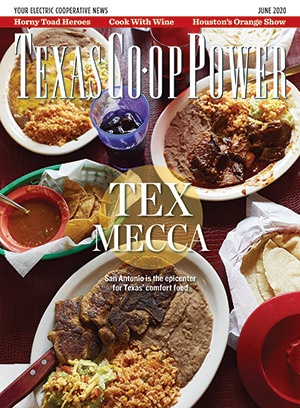As someone who grew up in Southeast Texas, I know the heat and humidity can drive a person to the brink of insanity. I believe it can also fuel an intense creativity and artistic vision. Mix this inspiration with lots of vitamin C, and you have the formula for one of the strangest art installations in the world: the Orange Show.
After navigating Houston’s urban maze, I turned into a neighborhood near the University of Houston, searching for a building-sized work of art. Even though I could see only modest midcentury houses, my phone assured me I was headed in the right direction. Then I found it: one of the state’s preeminent folk art installations. From the street, its colorful wrought-iron railings and white stucco walls made it resemble an abandoned carnival attraction. I imagined circus music as I stepped inside the Orange Show, but what I experienced was beauty and intrigue.
The installation began to take shape in 1956, when postal worker Jeff McKissack decided that the world needed to know about the health benefits of his favorite fruit and how hard work and good nutrition were the secret to a long and productive life. Even though he had no formal training in the arts, McKissack picked up scraps of lumber from trash piles and shopped flea markets and, piece by piece, created a maze of staircases, doorways and stages. It’s an orange-themed fantasy world.
Past the front gate, every turn revealed diagrams of orange-promoting propaganda. Phrases like “Go Orange. Be Strong” and “Love Me Orange” were inscribed in mosaics across the walls. Dioramas housed a half-dozen mannequins dressed in seemingly unrelated clothing: One with a hook for a hand stood near a clown who had found happiness by drinking cold, fresh orange juice. Another was Santa’s son, in full Christmastime regalia, hoping to plant oranges for everyone. Each display balanced between charmingly whimsical and downright creepy.
Outside, I climbed strange staircases and discovered two open-air stages surrounded by 80 metal tractor seats. Above the stages fluttered 45 metal birds and 10 waving Texas flags. The largest arena was a “pond” that didn’t hold water but did hold a stationary boat. What baffled me more than the art was the fact that McKissack had welded, paved and painted the entire experience by himself.
McKissack lived next door to his creation and worked tirelessly on the project until his death in 1980. Soon after, Houston’s art community formed a trust to steward the property. Today, the Orange Show Center for Visionary Art makes the art experience—and visionary art—accessible to the public. Nearby is the foundation’s newest project, Smither Park, with meandering paths and bright, mosaic-covered walls created to honor McKissack.
Some folks might wonder why this mashup of materials should be considered art, but that’s what makes folk art so amazing. It’s usually created by artists without formal training. Did McKissack know that he was creating art? Maybe not. But there’s no doubt he loved building it and sharing both his talents and love for citrus with the world.
Walking through the Orange Show is a stroll through the creative process. It’s weird. It’s wonderful. And it’s confusing. I left not really knowing what I had just experienced, and I was thirsty for a big, cold glass of orange juice.


